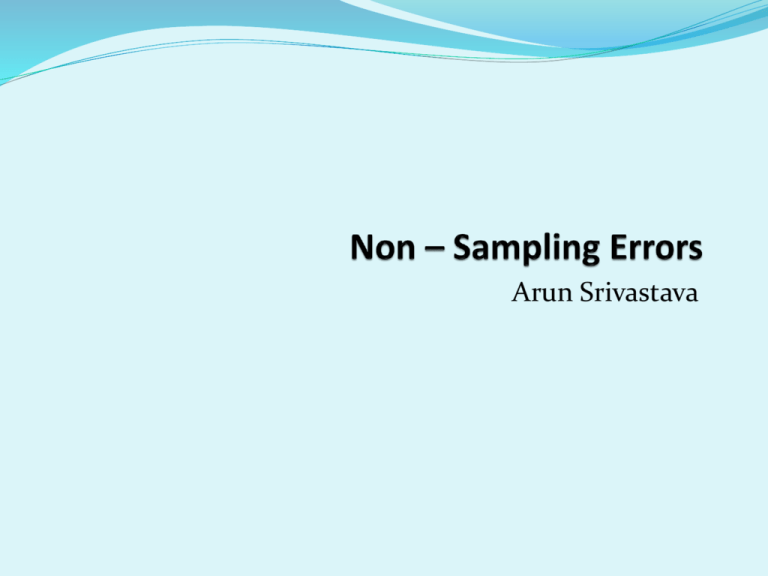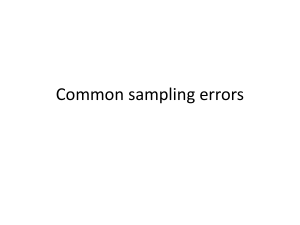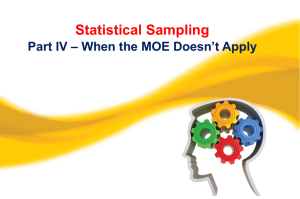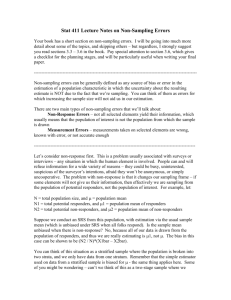Non-sampling errors
advertisement

Arun Srivastava Types of Non-sampling Errors Specification errors, Coverage errors, Measurement or response errors, Non-response errors and Processing error. Specification Errors This occurs when the concept implied by the question is different from the underlying construct that should be measured. A simple question such as whether a household is an agricultural household can be subject to different interpretations. The meaning of the questions must be conveyed in an unambiguous way and must be properly understood by the respondent. Coverage errors Under coverage - Omissions External units included Duplication Deliberate and considered exclusions are not coverage errors Updating the frame necessary. Measurement errors What is observed or measured departs from the actual values of sample units. These errors concern the accuracy of measurement at the level of individual units. Also called response error. Mathematical treatment of measurement errors is available in the form of linear response error models (Refer Cochran, W. G. (1977)). Models also used in the treatment of interpenetrating net-work of sub-sampling which is used for estimating the enumerators’ effect. Non-response errors Failure to get response from some of the sample units. Population may be conceived as having two strata, i) consisting of all sample units for which measurements can be obtained and ii) for which no measurements could be obtained. Non-response errors (Contd.) Hansen and Hurwitz (1946) -Call-back methods. Politz and Simon (1949) – No call backs but by asking to the respondent as to how many times he was at home during previous week to tackle non-response due to not at home. Unit and Item Non-response Unit non-response - no information is obtained from certain sample units – may be due to refusal or no contact. Item non-response - for some units, information not collected for some items. Gaps in the data records for responding sample units. Reasons may be due to refusals, omissions by enumerators and incapacity. Imputations. Processing errors Processing errors comprise of: — Editing errors. — Coding errors. — Data entry errors. — Programming errors etc. Interpenetrating sub-sampling Mahalanobis (1946). Instead of selecting n units in a sample, k sub-samples of size m=n/k are selected independently. The field work and processing of the sample are planned so that there is no correlation between the errors of measurement of any two units of in two different subsamples. For instance, suppose that the correlation with which we have to deal arises solely from biases of the enumerators. If each of k enumerators is assigned to a different sub-sample and if there is no correlation between errors of measurement for different interviewers, we have an example of this technique. Interpenetrating sub-sampling (Contd.) With a suitable model it is possible to estimate the relative amount which the correlated component (in this case due to interviewer’s effect) of the response variance contributes to the total variance. The technique has also been very helpful in estimation of variances for complex statistics. Evaluation of NSE Consistency checks In designing the survey instruments (questionnaires), care should be taken to include certain items of information that will serve as a check on the quality of the data to be collected. If the additional items of information are easy to obtain, they may be canvassed for all units covered in the survey, otherwise, they may be canvassed only for a sub-sample of units. It is also desirable to follow some external consistency checks on salient results thorough comparable data sources. It is important for validity as well as acceptability of the estimates. Evaluation of NSE (Contd.) Sample check/verification One way of assessing and controlling non-sampling errors in surveys is to independently duplicate the work at the different stages of operation with a view to facilitating the detection and rectification of errors. Sample check only on small samples using a smaller group of well-trained and experienced staff it would be possible, not only to detect the presence of non-sampling errors, but also to get an idea of their magnitude. Evaluation of NSE (Contd.) Post-survey checks An important sample check, which may be used to assess non-sampling errors, consists of selecting a subsample, or a sample in the case of a census, and reenumerating it by using better trained and more experienced staff than those employed for the main investigation. Usually the check-survey is designed to facilitate the assessment of both coverage and content errors. For this purpose, it is first desirable to re-enumerate all the units in the sample at the high stages, e.g. EAs and villages, with the view of detecting coverage errors and then to re survey only a sample of ultimate units ensuring proper representation for different parts of the population which have special significance from the point of view of non-sampling errors. Evaluation of NSE (Contd.) With the sample check, rectification work can only be carried out on the sample checked. This difficulty can be overcome by dividing the output at different stages of the survey, e.g. filled in schedules, coded schedules, computation sheets, etc., into lots and checking samples from each lot. In this case, when the error rate in a particular lot is more than the specified level, the whole lot may check and corrected for the errors, thereby improving the quality of the final results. Evaluation of NSE (Contd.) Post-survey checks Post survey checks by selecting a sub sample and re- enumerating it by using better trained and more experienced staff than those employed for the main investigation. Usually the check-survey is designed to facilitate the assessment of both coverage and content errors. Re-enumerate all the units in the sample at the high stages, e.g. EAs and villages, with the view of detecting coverage errors and then to re survey only a sample of ultimate units ensuring proper representation for different parts of the population which have special significance from the point of view of non-sampling errors. THANKS






